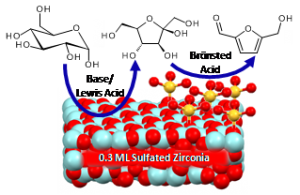With context to the ever increasing problem of dwindling energy resources, sugars like 5-Hydroxymethylfurfural (5-HMF) and furfural are considered to be the key for next-generation energy demands. These sugars have been recently identified to have potential applications in the petrochemicals and plastic industry. While efforts are ongoing to find a cheaper and greener way for the production of 5-HMF, it has eluded most of the researchers till now.
In their quest for a total green 5-HMF synthesis, the authors moved towards sulfated zirconia as a bifunctional catalyst for the one-pot conversion of glucose to 5-HMF in aqueous phase. It has been observed that isomerisation of glucose to fructose is possible with zirconia, and the subsequent dehydration of fructose to 5-HMF with sulfated zirconia (SZ). The authors tried to capitalize on their previous experience of employing SZ in aqueous media and went on to create the first ever bifunctional catalyst for 5-HMF production in water. The key towards the holy grail was tuning the acid strength in SO2/ZrO2 to achieve both the isomerisation and dehydration through a single bi-functional catalyst.
The amphoteric nature of zirconia was explored and tuned by adjusting the sulfate loading onto the metal, as the surface sulfate density directly relates to the acidity of the catalyst. The extensive investigations by the researchers showed that zirconia exists in a monoclinic state with large lewis base sites, which converts to a more stable tetragonal structure on sulfate addition with abundance of bronsted acid sites. The lewis base sites catalysed the glucose –> fructose isomerisation and the bronsted acid sites accelerated the fructose –> 5-HMF dehydration. This knowledge helped them in optimising the sulfate loading to 0.3 ml which gives a perfect platform for Glucose –> Fructose –> 5-HMF conversion.
To read more about the art of synthesizing such novel bifunctional catalysts, follow the link below:
Bifunctional SO4/ZrO2 catalysts for 5-hydroxymethylfurfural (5-HMF) production from glucose












